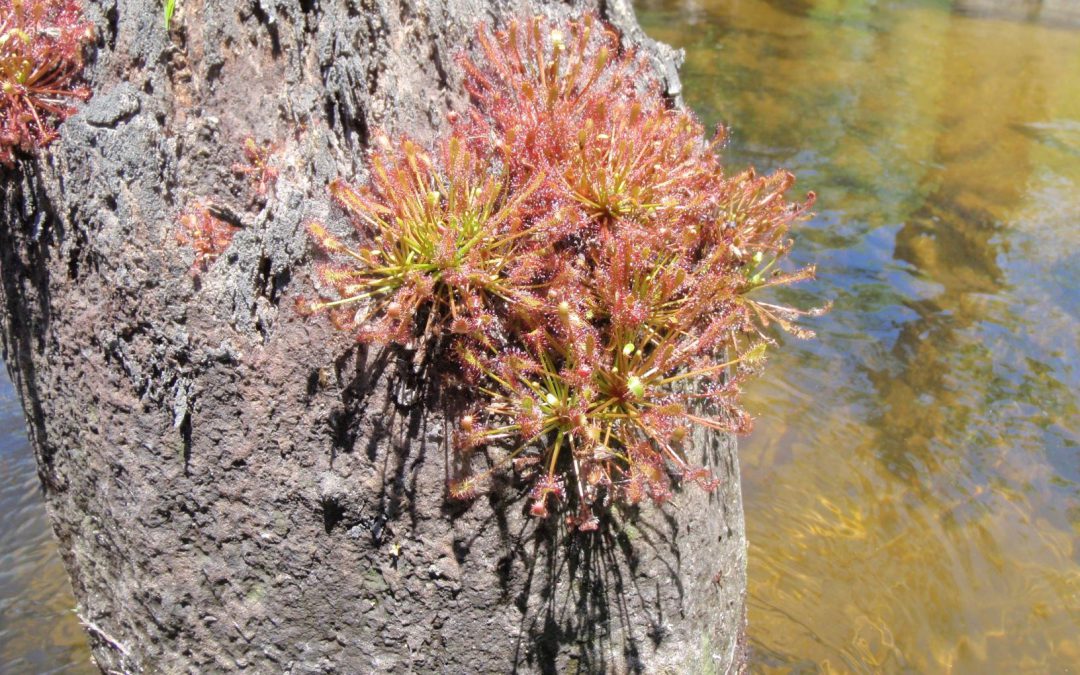
by Carrie Stevenson | Jun 4, 2020
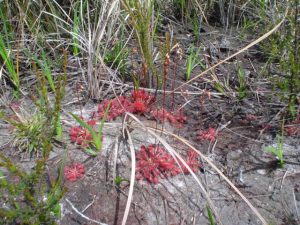
Sundews, tiny carnivorous plants found in pitcher plant bogs, use an enzyme dissolve insect proteins. Native Americans recognized this property and used the plant for skin maladies. Photo credit: Carrie Stevenson, UF IFAS Extension
There are few words better than “pure delight” to describe the face of someone who sees and appreciates a sundew for the first time. Maybe it is their size—often no bigger around than a quarter—or the miniature pinwheel shape, but sundews could easily fit into a fable about garden gnomes or fairies in the woods. These tiny plants hide in plant sight–so small and flush to the ground that you likely won’t see them unless specifically looking for them. But, once you are looking in the right conditions, you will probably see them everywhere.
Sundews (Drosera spp.) are small carnivorous plants found in the same bogs as pitcher plants. They thrive in moist, mucky soil and full sun. They are also carnivorous for the same reasons pitcher plants are—their wet, acidic habitats possess few soil nutrients, so they use insects instead.
Sundews utilize a different method for trapping insects—their flat, radiating structure has wider lobes on the ends, which are covered with hairlike tentacles. These hairs secrete droplets of sticky sap visible at the tip of each hair. Small insects are attracted to the dewlike sap and get stuck. The hairs curl around the insect like a slow Venus flytrap, and natural enzymes to break down the bug.
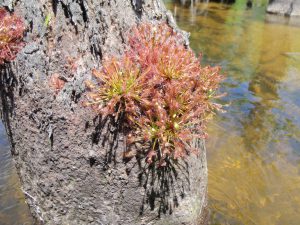
A healthy sundew plant growing just above the water level at Boiling Creek in Santa Rosa County. Photo credit: Larry Burner, Florida Master Naturalist
There are almost 200 species of sundews, not all with the flat growth pattern. The threadleaf sundew has an upright structure, while others may grow in a spherical shape at the water’s edge. While paddling Boiling Creek on Eglin Air Force Base property a few years ago, our group saw dozens of sundews growing on the trunks of cypress and tupelo trees at eye-level from our kayaks. They were about 4-6” in diameter, much larger than the 1” ones we typically see in the bogs.
Tarkiln State Park, Weeks Bay National Estuarine Research Reserve, or any place you find pitcher plants are a great place to find sundews. You may have to get on your knees to see them, and move the grasses aside. Bring a hand lens to magnify the delicate details of the droplets of sap perched at the tip of tiny hairs.
Even the famous naturalist Charles Darwin was enthralled with sundews, conducting experiments and writing volumes about them. In an 1860 letter to his geologist friend Charles Lyell, Darwin stated that, “at the present moment, I care more about Drosera than the origin of all the species in the world.” If you, too, are fascinated with carnivorous plants, check out these resources from UF IFAS Extension and the Botanical Society of America.
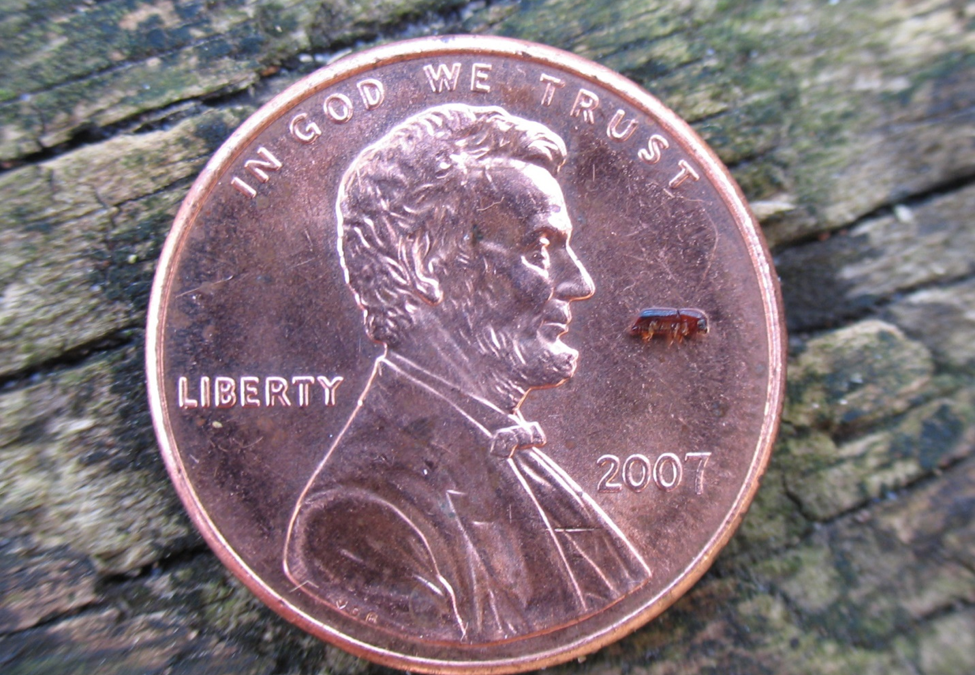
by Carrie Stevenson | Jun 4, 2020
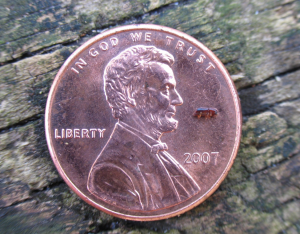
Fig. 1 An adult redbay ambrosia beetle compared to the size of a single penny. Credit: UF/IFAS File Photo.
While most bark beetles are important in forest ecology by recycling fallen dead trees and eliminating sick and damaged trees, some of them may impact healthy trees. A group of bark beetles that has become a major concern to forest managers, nurseries, and homeowners is the ambrosia beetle. Ambrosia beetles are extremely small, 1-2 mm in length, and live and reproduce inside the wood of various species of trees (Fig. 1). Ambrosia beetles differ from other bark beetles in that they do not feed directly on wood, but on a symbiotic fungus that digests wood tissue for them. Every year, non-native species of ambrosia beetles enter the United States through international cargo and we have now nearly forty non-native species of ambrosia beetles confirmed in the United States. Among them, the redbay ambrosia beetle (Xyleborus glabratus), originally from Southeast Asia, is the vector of the fungal pathogen causing laurel wilt, a disease that devastated the Lauracaea population in the southeastern USA, killing millions of redbay, swamp bay, sassafaras and silk bay.
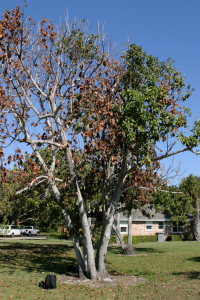
Fig. 2: A mature dooryard avocado tree with large sections of dead and missing leaves, caused by laurel wilt disease. Summer 2009 Impact Magazine image. Credit: UF/IFAS File Photo.
When these beetles attack a laurel tree, the symbiotic fungus is vectored to the tree’s sapwood after the beetle has tunneled deep into the tree’s xylem, actively colonizing the tree’s vascular system. This colonization leads to an occlusion of the xylem, causing wilting of individual branches and in a matter of weeks progresses throughout the entire canopy, eventually leading to tree death (Fig. 2). The laurel wilt disease has spread rapidly after the vector was first detected in Georgia in 2002. The redbay ambrosia beetle was first detected in Florida in 2004, in Duval County, attacking redbay and swamp bay trees. At this point, it is estimated that more than one-third of redbay in the U.S.A., 300 million trees, have succumbed to the disease.
Starting in 2017, we examined the efficacy of verbenone against redbay ambrosia beetle in live laurel trees in a natural forest setting. Verbenone is an anti-aggregation pheromone that has been used since the 1980’s to protect lodgepole pine. Verbenone also has the potential to be used over large areas and is currently being used to protect ponderosa pine plantations from the Mountain Pine Beetle in the western US.
We have found verbenone to be an environmentally friendly and safe tool to prophylactically protect laurel trees against redbay ambrosia beetle. Our protocol consists of the application of four 17 g dollops of a slow-release wax based repellent (SPLAT Verb®, ISCA technology of Riverside, CA) to the trunk of redbay trees at 1 – 1.5 m above ground level (Fig. 3). The wax needs to be reapplied every 4 months during fall and winter and every 3 months during spring and fall when temperature is higher. When compared to the control trees without repellents, we found that trunk applications of verbenone reduced landing of the redbay ambrosia beetle on live redbay trees and increased survivorship of laurel trees compared to untreated trees (Fig. 4). Verbenone should be considered as part of a holistic management system against redbay ambrosia beetle that also includes removal and chipping of contaminated trees.
If you have Redbay or other bay species on your property and are concerned about Laurel Wilt Disease or Redbay Ambrosia Beetle damage, contact your local UF/IFAS Extension Agents for help!
This article is courtesy of Dr. Xavier Martini and Mr. Derek Conover of the UF/IFAS North Florida Research and Education Center (NFREC) in Quincy.
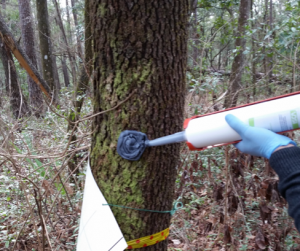
Fig. 3: Application of SPLAT Verb on a redbay tree during a field trial

Figure 4: (A): Cumulative capture of redbay ambrosia beetles Xyleborus glabratus following a single application of verbenone vs untreated control (UC). (B) Survivorship of redbay and swamp bay trees treated with verbenone on four different studies conducted in 2017 and 2018.

by Larry Williams | May 14, 2020
When we go through dry periods in North Florida some residents become interested in drought-tolerant plants to include in their landscapes. The need for irrigation can be reduced when drought-tolerant plants are used. But don’t overuse these plants. Remember we have periods of rainy weather, too.
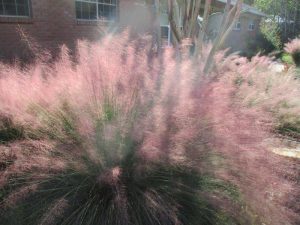
Gulf Muhly Grass in Flower. Photo credit: Larry Williams
Some drought-tolerant plants have poor tolerance to the other extreme – too much water. There are a few plants that can tolerate both extremes but they are the exception. Avoid using drought-tolerant plants on naturally wet or poorly drained sites. But if you have the typical deep sandy well drained soil Florida is famous for, you’d do well to include some drought-tolerant plants on your site.
Drought-tolerant plants are especially well suited for areas that receive little to no irrigation.
Some plants are genetically better able to withstand drought. They have a built-in tolerance of drought. Many of our Florida native plants are designed to grow in our poor water holding sandy soils. Many of the plants native to arid areas of the world possess high drought-tolerance. These plants have characteristics that allow them to better survive dry weather. These features include thicker or waxier leaves, large surface root areas or deep roots and the ability to drop leaves in drought and regain them when moisture is adequate.
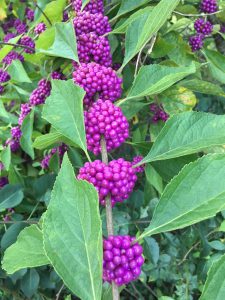
Beautyberry with fruit. Photo credit: Larry Williams
It’s important to realize that these plants must first establish a root system before they can cope with severe dry weather. Plan to irrigate during dry periods for the first season to allow them to become established.
Some outstanding trees to consider include crape myrtle, redbud, Chinese pistache, cedar (Cedrus species), hawthorn (Crataegus species), American holly, yaupon holly, Southern red cedar (Juniperus species), Live oak, Sand live oak, winged elm, pond cypress and bald cypress. Some people are surprised to learn that pond cypress and bald cypress have high drought-tolerance because these trees are associated with swamps, many times growing in standing water. But once established on a dry site, they exhibit very good drought-tolerance.
Some outstanding shrubs with drought-tolerance include glossy abelia, dwarf yaupon holly, Indian hawthorn (Rhaphiolepis species), beauty berry (Callicarpa americana), pineapple guava, junipers, oleander, spiraea, blueberry or sparkleberry (Vaccinium species), viburnum, Chaste tree (Vitex agnus-castus) and coontie (Zamia pumila).
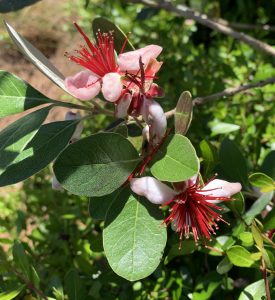
Pineapple guava in bloom. Photo credit: Larry Williams
Some outstanding drought-tolerant groundcovers to consider include beach sunflower (Helianthus debilis), daylily, juniper, lantana, liriope, rosemary (Ceratiola ericoides), Asiatic jasmine and society garlic. Many of the ornamental grasses such as Gulf muhly are good choices as well.
For more ideas on developing a Florida-friendly, water wise landscape, contact the UF/IFAS Extension Office in your County or visit the below website. https://ffl.ifas.ufl.edu/index.html
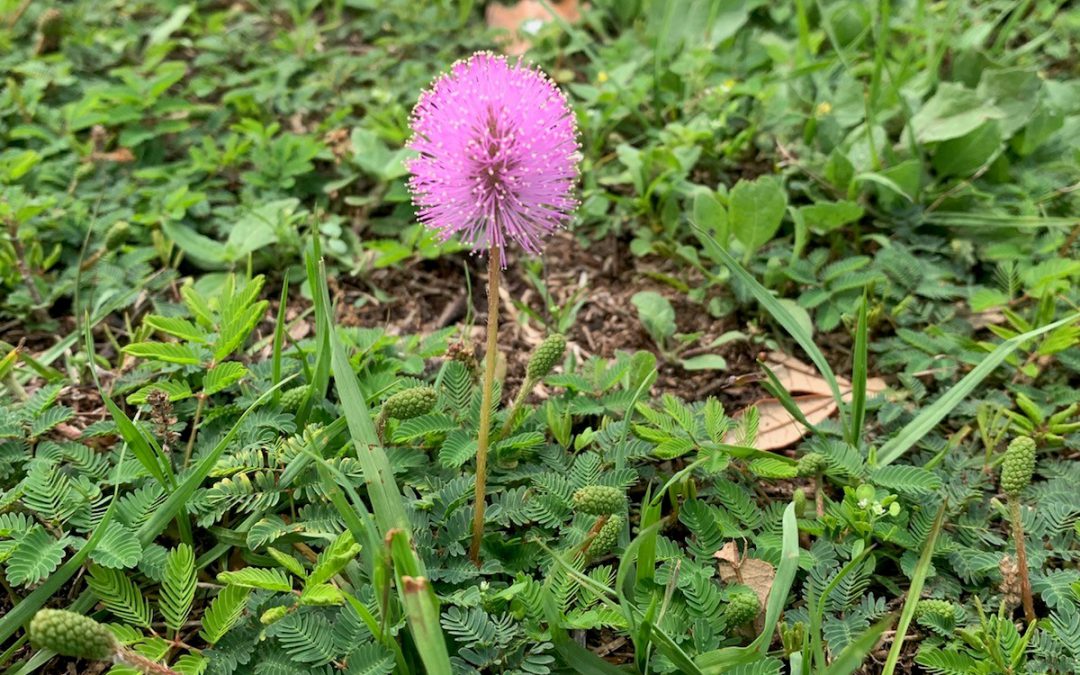
by Ray Bodrey | May 13, 2020
Powderpuff mimosa (Mimosa strigillosa), also called Sunshine Mimosa or Sensitive Plant, is an increasingly popular native plant for home and commercial landscape applications that offers a very show display of puffy pink flowers this time of year!
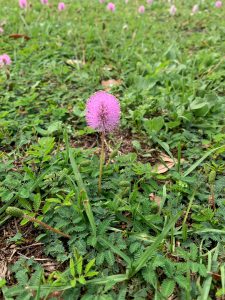
Powderpuff Mimosa, (Mimosa strigillosa). Photo courtesy of Ray Bodrey.
This Florida native, low-growing groundcover grows no more than eight inches in height, and that would be classified as an extremely vigorous stand. Powderpuff Mimosa is technically a perennial legume, meaning it doesn’t need any nitrogen fertilizer from gardeners.
The groundcover is appealing to the eye with its dark green fern-like leaves. Not an evergreen, the plants fall into a semi-dormant to dormant state during the fall and winter seasons. Powderpuff Mimosa is a very resilient groundcover as well, needing little irrigation, spreading quickly, and co-existing well with turfgrass. Just a few pots of this species transplanted should cover up to 300 square feet in a season. Although it spreads quickly, it can easily be pruned or mowed if it moves into unwanted areas.
Powderpuff mimosa is a great plant for erosion control due to its deep roots. These deep roots also allow for good levels of drought tolerance. There are very few insect or disease problems with this plant, other than the occasional caterpillar. It is a very wildlife and pollinator friendly plant, with honeybees, butterflies, deer, and more all finding it appealing. It’s even considered a livestock forage, as cattle find it palatable.
Looking to plant powderpuff mimosa in your landscape? Any area that gets mostly full sun is just fine. This plant is adapted to a wide range of soils, but particularly flourishes in well-drained, sandy loam soils. Be sure to water regularly, especially to ensure successful establishment in your landscape. Find this wonderful little plant at Florida native plant nurseries!
For more information contact the Gulf County Extension Office at 639-3200 or email at rbodrey@ufl.edu.
Supporting information for this article can be found in the UF/IFAS Extension website: https://gardeningsolutions.ifas.ufl.edu/plants/ornamentals/powderpuff-mimosa.html & USDA website: https://plants.usda.gov/plantguide/pdf/pg_mist2.pdf
UF/IFAS Extension is an Equal Opportunity Institution.
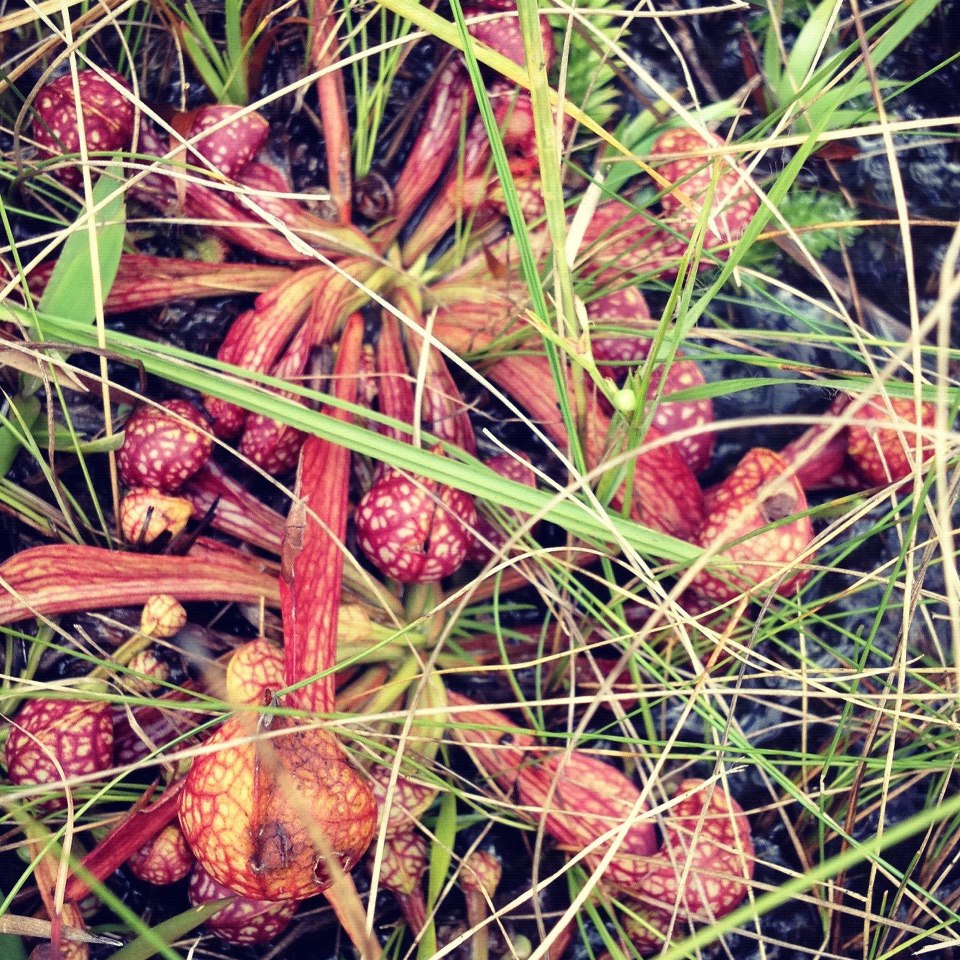
by Carrie Stevenson | Apr 30, 2020
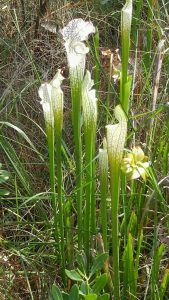
White-topped pitcher plants in bloom at Tarkiln State Preserve. Photo credit: Carrie Stevenson, UF IFAS Extension
If you live in northwest Florida or southeast Alabama and have never laid eyes on our wild native carnivorous plants, it is about time! April and early May are the best times to see them in bloom. We have six species of pitcher plants (Sarracenia), the most common being the white-topped (Sarracenia leucophylla). However, they come in multiple colors, from yellow and red to a deep purple, and in different sizes.
One thing they all have in common, though—they eat meat. Carnivorous plants all over the world have evolved in places that left them few other options for survival. These plants are typically found in extremely wet, acidic, mucky soils with very low nutrient levels. Normally, plants uptake nutrients like nitrogen and phosphorus from the soil around them. Not being available in these particular environments, carnivorous plants (or more specifically, insectivorous) developed a way to extract nutrients from insects.
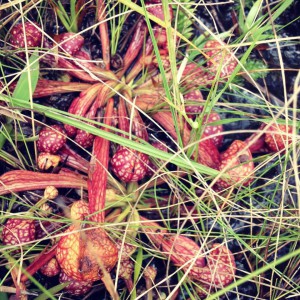
Small parrot pitcher plants lie on the ground instead of standing upright at Blackwater State Forest. Photo credit: Carrie Stevenson, UF IFAS Extension
So how does it work? Pitcher plants have a modified leaf, which instead of lying out flat like most plants, is rolled up into a tube, or “pitcher” shape. The inside of the pitcher has a sweet sap, and the walls of the tube are lined with tiny, downward-pointing hairs. Separate from the leaf, the plant has an elaborate flower structure, which attracts insects for pollination. While nearby, these insects are also attracted to the colorful leaf and the sweet sap in its pitcher. The insect will land on the lip of the leaf, then crawl down.
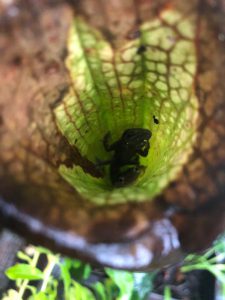
A lizard waits patiently a the bottom of a pitcher plant, hoping to catch insect prey. Photo credit: Carrie Stevenson, UF IFAS Extension
Those sticky, downward facing hairs are a trap, preventing insects from leaving the pitcher. Enzymes—a cocktail of proteins naturally found in many other plants but used creatively here—in the sap break down the bug bodies and convert them to nutrients for the plant. In fact, if you slice a cross-section into a pitcher wall or break open a dried one, you will see countless dried exoskeletons at the bottom of the tube. Several other enterprising species have taken advantage of the pitcher plant’s creative structure. More than once, I have seen tiny spiders spin webs across the mouth of the tube, or small lizards and frogs at the bottom, waiting patiently for prey.
Some of the best places to see pitcher plants in the area—they also bloom in October—are Tarkiln Bayou State Preserve, Weeks Bay National Estuarine Research Reserve, Splinter Hill Bog Preserve, and Blackwater State Forest.
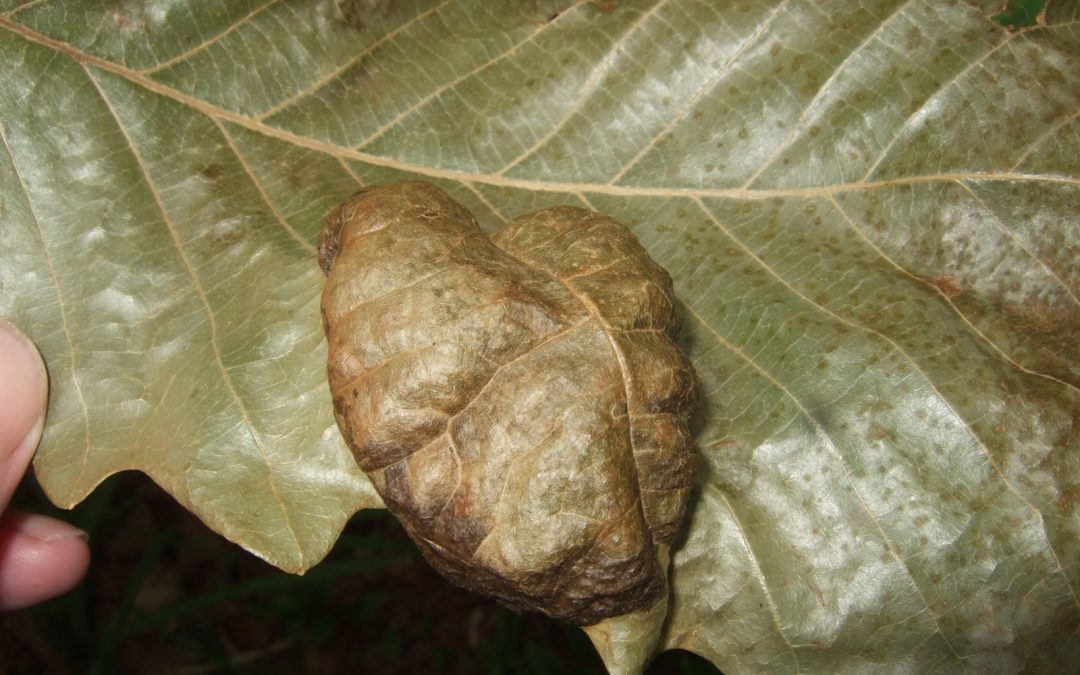
by Mark Tancig | Apr 30, 2020
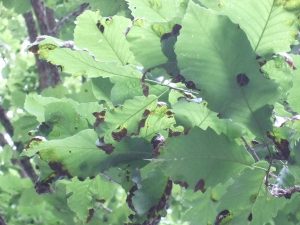
Symptoms of oak leaf blister on swamp chestnut oak. Credit: Gordon Magill.
Even during global pandemics, it’s a joy to be outside during the great north Florida spring we’ve been experiencing lately. As cold fronts come through with their rain bands, some packing a punch, they leave behind the most pleasant mornings, clear blue daytime skies, and crisp evenings. Unfortunately, we’re not the only organism that also enjoys those cool days. Many species of fungi are quite active this type of year as the rains, followed by warmer, yet not too hot temperatures, create the perfect conditions for fungal growth. Some of these fungi grow right on or in the plants we’d like to be enjoying for ourselves, stealing nutrients and causing plant decline or merely causing aesthetic damage. As this is an active time for certain species of fungi, local extension offices are getting more calls and questions regarding lawn and landscape damage due to fungal pathogens. A recent call was a new one for me and an example of a native fungi-plant interaction that looks bad but requires no intervention from us. It also highlights how correctly identifying a disease leads to the best action and can often save time and money and prevent unnecessary pesticides (in this case a fungicide) from entering the environment.

Close up of oak leaf blister on swamp chestnut oak. Credit: Gordon Magill.
The fungi and plant involved here was the oak leaf blister (Taphrina caerulescens) on a swamp chestnut oak (Quercus michauxii). It forms, you guessed it, blisters on the leaves of any of the oaks, though live oak (Quercus virginiana), laurel oak (Quercus laurifolia), and water oak (Quercus nigra) seem to be preferred hosts. The spores of the fungi, dormant since the previous summer/fall and which happen to get lodged in bud scales through wind and rain, germinate in cool, wet weather. The fungus then infects young leaves as they flush and its growth causes a disruption in the leaves’ development. This leads to the blistered look of the leaf tissue and, during extended periods of cool, wet weather, the entire leaf sort of shrivels, browns, and eventually falls off. Spores are eventually released from the fallen leaves to start the process over the next spring.

Severe oak leaf blister on swamp chestnut oak. Credit: Gordon Magill.
Though the leaves look pretty terrible, this fungal disease rarely causes plant health issues and the tree recovers just fine. Specimen trees that experience it year to year may be treated with a fungicide, but most homeowners can just let it go. Raking up and disposing of the leaves may help prevent further infections by reducing the number of spores released in the area.
As you enjoy another cool morning after an evening rainstorm, remember that the fungi all around you are also having a great day. You may want to look at your landscape plants and see if there’s anything abnormal going on. If so, take a photo and send it to your local extension office for help with identification and best methods of control, or, like in this case, just leaving it alone.
p.s. As I said this was a new one for me and I want to thank Stan Rosenthal, Extension Agent emeritus, for assisting with identification.






















